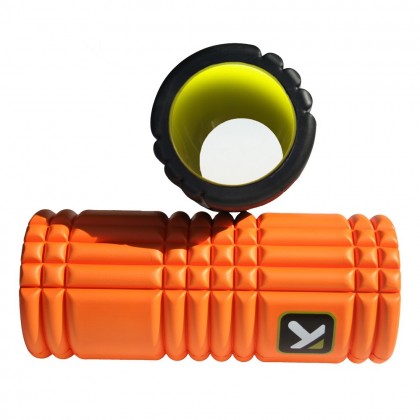
This past winter, I had the misfortune (though, perhaps in the long run it was a blessing) of dealing with a hamstring injury. Cross-training didn’t help with the recovery. Physical therapy gave the tools to help minimize future risk of hamstring issues, but really didn’t help much with the short term recovery either. It was only through Active Release Therapy (ART) massage that I was finally able to get back through running.
It was clear at that time that managing the build-up of scar tissue in my hamstrings was going to be an ongoing battle. ART is a great tool for breaking up the adhesions that can lead to strains, but it is a bit pricey and time-consuming. Therefore, I dove into the world of foam rolling for the first time, to be able to manage the injury risk myself.
When shopping for foam rollers, one model stood out, The GridTM from Trigger Point Performance Therapy. I had seen numerous complaints posted about the tendency of “true” foam rollers to deform under time and lose their effectiveness. Thus, while The Grid was significantly more expensive than other models, it seemed a worthwhile investment.
I wasn’t disappointed. The Grid is capable of supporting my full body weight, allowing me to put a lot of pressure on the areas of concern, whether in my hamstring, calf, IT band, or quad. As such, it provided a speedy and effective way of working out the kinks, helping salvage many a next-day run that I feared would be nigh impossible given the condition after a long tempo run or back-to-back long runs.
Perhaps the grid design also helped in this process, allowing the nodules of the roller to penetrate and separate the adhesions in the hamstrings. I could literally feel the knots being squeezed out which, as you might expect, was briefly painful but so helpful in the long run. Another advantage of The Grid is that the hollow core makes it easy to pack for travel, as you can stuff items such as socks or running shirts and shorts inside this core, saving space.
Rolling requires just a few minutes, a couple of times per week, to make a noticeable difference in your ability to recover and maintain a high-mileage training program. You can squeeze it in while watching television, or, if you are like us and don’t watch much TV, while supervising your children as they drift off to sleep. It is complimentary to, but much less fatiguing than, self-massage (or, if you are lucky enough, massage from a partner). And it is far cheaper than the regular trip to the chiropractor or massage therapist. In fact, I have yet to undergo an ART session since starting to use the foam roller. And given the 8-minute PR and marathon victory at the Towpath Marathon, it seems the treatment works.
About the author: Greg Strosaker is the product manager, father, husband, and 2:55 marathoner behind the Predawn Runner blog, where he writes about training, running gear, motivation, and how running helps build your character, all for those trying to squeeze serious training into their busy lives.
Have something to say? Leave a Comment
I own one of these babies too, and am currently using it in conjunction with weekly ART from my chiro. I highly recommend it, and it is painful, but needs to be done right??
You might also want to try the RumbleRoller. It gets even deeper into the hamstrings.
1. Rather than a foam roller, which cost upwards of $25, I was lucky enough to find a 4" diameter piece of PVC drainage pipe. I cut off a piece about 30" long. Works fine. However, my hammy scar tissue is still there and I cannot yet resume running.
2. OK, I'm pickin-a-nit : In your article you used the word " complimentary ". You really should use " complE mentary ". 🙂
A 70 year old runner for 37 years…. and still going